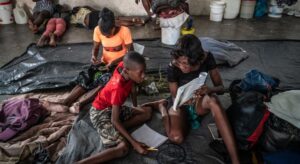
[ad_1]
In Cité Soleil, a neighborhood of Haiti’s capital, the number of hunger victims has reached catastrophic levels, whichIntegrated Food Security Phase Classification index / IPCThe highest level, under the classification of ‘, is 5.
According to the IPC analysis, the way 47 lakh people are facing hunger, there is a threat to their life and livelihood.
1.8 million people are acutely food insecure, and for 19,000 people the food security situation has reached catastrophic levels, a first for Haiti.
Most of the people in the Cite Sole area are extremely poor and are forced to face the most risks. Of these, the situation is becoming serious for about 65 percent of the population, and five percent of the population will need to be provided with immediate humanitarian assistance.
Things have become increasingly difficult for local residents as violence escalates and armed groups struggle for supremacy in the capital, Port-au-Prince. Markets, health and nutrition services have been affected due to the anarchy and many people have been forced to leave their homes or not to step out of their homes.
rural insecurity
The food security situation in rural areas is also getting worse, and in many areas the situation is moving from ‘crisis’ to ’emergency’ category.
The country is in dire straits due to the loss of crop yields due to less than average rainfall and the earthquake that will devastate some areas of Haiti in 2021, as well as the political and economic crisis.
“These are tumultuous times for Haiti,” said Jean-Martin Boya, the country director for the World Food Programme. But there is a way forward. We all need to focus on delivering immediate humanitarian aid and support for long-term development.”
Natural hazards and political upheaval over the years have created dire conditions for Haitians in rural and urban areas who were already in need.
The onset of a global food crisis with rising food and fuel prices has created unrest in the country, and Haiti is now in chaos. Economic activities and transport system have come to a standstill.
In Haiti, even basic food items are becoming out of reach, inflation is 33 percent and the price of gasoline has doubled.
humanitarian aid efforts
The World Food Program has delivered emergency relief to more than a million people this year, despite the difficult security situation in the capital Port-au-Prince.
The UN agency’s focus is on strengthening national social protection and food systems that are focused on country recovery and sustainable development.
Over the next six months, the UN agency is appealing for $105 million in crisis relief action to address the root causes and strengthen the resilience of Haiti’s people.
Food and Agriculture Organization (FAO) has also ensured emergency livelihood support for communities dependent on small-scale agriculture. In this sequence, there is a plan to provide cash, crop production assistance, food storage and processing and other types of support to 70 thousand people in lieu of work.
It has been told that the UN agency will need 33 million dollars to provide help to 470,000 most needy people.

Insecurity has increased in Haiti’s capital Port-au-Prans since the assassination of the former president.
cholera outbreak
Nearly one lakh children under the age of five in the country are already suffering from severe malnutrition and now the cholera outbreak has further increased their risk.
United Nations Children’s Fund (UNICEF) has issued a warning that malnourished children have very weak immune systems, making them three times more likely to die from cholera.
The first case of cholera was reported on 2 October, and so far 357 suspected cases have been detected, more than half of which have been reported in children under the age of 14.
The risk has been reported to be highest for children aged one to four years.
Haiti’s health system is overburdened and teetering on the brink of collapse after armed gangs took over the country’s main fuel terminal.

People line up to collect cleaning kits in Haiti.
health system impact
There are about three quarters of hospitals across the country, which depend on diesel generators for electricity, and due to fuel shortage, regular services are no longer possible there.
Due to fuel shortage, only three ambulances are operating in the capital Port-au-Prince, and there are probably no such arrangements in other parts of the country.
Vulnerable populations, including women and girls, are most affected by the limited availability of health services.
UN Agency for Sexual and Reproductive Affairs (UNA)UNFPAAccording to an estimate of ), about 30,000 pregnant women in the country are at risk of missing out on much-needed health care.
Thousands of women’s lives are at risk due to complications during childbirth and limited medical facilities.
Seven thousand women who have been victims of sexual violence are feared to be deprived of medical and psychosocial support by the end of this year.
Saidu Kabouré, the UN agency’s representative in Haiti, said that despite the grave security situation and fuel shortages, UNFPA, together with its partner organizations, has operated mobile clinics and aid is being delivered to the displaced within the country’s borders.
[ad_2]
Source link





